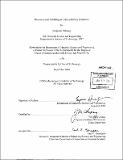Microstructural modeling of lithium battery electrodes
Author(s)
Hellweg, Benjamin, 1974-
DownloadFull printable version (6.100Mb)
Other Contributors
Massachusetts Institute of Technology. Dept. of Materials Science and Engineering.
Advisor
Yet-Ming Chiang.
Terms of use
Metadata
Show full item recordAbstract
The transport of charged species in lithium ion batteries was studied from a microstructural point of view. Electron transport was analyzed using percolation theory and comparison with other conductor-insulator composites. An in situ filter pressing apparatus was designed and constructed in order to determine the percolation threshold in composite electrode systems. In addition, the effect of inter-particle interactions was qualitatively examined. The percolation threshold was determined to occur between 10 and 13 volume percent conductor loading for liquid electrolyte systems. In dissolved polymer systems, polymer adsorption shifted the percolation threshold to 25 volume percent. Ion transport was analyzed using a computer model designed by Doyle and Newman. Microstructural solutions to ameliorate the rate limiting steps were proposed and tested. Battery simulations demonstrated that the rate capability of lithium batteries could be improved both by utilizing plate-like particles aligned in parallel with the current flow, and also by producing a porosity gradient in the electrode. Using particles aligned parallel to the current flow allowed the elimination of tortuosity from the ion path. Graded electrodes provided superior ion transport near the electrode surface, where the ionic current is greatest, while additional capacity was available in the depth of the electrode, where ion transport was not as critical.
Description
Thesis (S.M.)--Massachusetts Institute of Technology, Dept. of Materials Science and Engineering, 2000. Vita. Includes bibliographical references (p. 200-201).
Date issued
2000Department
Massachusetts Institute of Technology. Department of Materials Science and EngineeringPublisher
Massachusetts Institute of Technology
Keywords
Materials Science and Engineering.